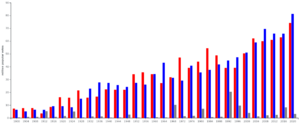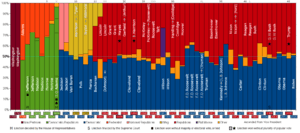List of United States presidential elections by popular vote margin facts for kids
In a United States presidential election, the popular vote is the total number of votes a candidate gets from people across all 50 states and Washington, D.C.. The candidate who receives the most votes nationwide is said to have won the popular vote.
However, the popular vote is not what decides who becomes the president or vice president. This is because presidential elections are indirect elections. When people vote on Election Day, they are not voting directly for a candidate. Instead, they are voting for people called electors who are part of the Electoral College. These electors then formally choose the president and vice president.
Because of this system, it's possible for a candidate to win the popular vote (meaning more people voted for them) but still lose the election. This has happened five times in US history, most recently in the 2016 election.
The rules for electing the president and vice president come from the Twelfth Amendment to the United States Constitution (added in 1804). This amendment explains how electors vote separately for each office. Before this, electors voted for two presidential candidates, and the one with the most votes became president, while the second-place person became vice president. Each state's legislature decides how its electors are chosen. Since 1880, all states have used the popular vote to pick their electors.
The 1824 election was the first time the popular vote was fully counted and reported. Since then, there have been 19 presidential elections where the winner did not get more than half of the popular votes. Since the 1988 election, the popular vote in presidential elections has been very close, with winners often winning by less than 10% of the votes. This is the longest period of close popular vote results since the 1820s.
Contents
Understanding the Popular Vote
The popular vote is simply the total number of individual votes cast for each candidate by regular citizens. It shows which candidate was preferred by the most people across the country. However, the US system uses the Electoral College, which means winning the most individual votes doesn't always guarantee a win.
Why the Electoral College Matters
The Electoral College is a group of electors chosen by each state. The number of electors a state gets depends on its population. When you vote for president, you are actually voting for a group of electors who have promised to vote for your chosen candidate. In most states, the candidate who wins the popular vote in that state gets all of that state's electoral votes. This is called a "winner-take-all" system.
Because of this system, a candidate can win many states by a small margin, earning lots of electoral votes, while another candidate might win a few states by a very large margin, getting fewer electoral votes overall. This is how a candidate can win the presidency without winning the nationwide popular vote.
Elections Where the Popular Vote Winner Lost
It's a big deal when a candidate wins the most individual votes but doesn't become president. This has happened five times in US history:
- 1876: Rutherford B. Hayes won the election, but Samuel J. Tilden had more popular votes.
- 1888: Benjamin Harrison won the election, but Grover Cleveland had more popular votes.
- 2000: George W. Bush won the election, but Al Gore had more popular votes.
- 2016: Donald Trump won the election, but Hillary Clinton had more popular votes.
These elections show how the Electoral College system can lead to different outcomes than the popular vote.
How Elections Are Decided
To become president, a candidate needs to win a majority of the Electoral College votes. There are 538 electoral votes in total, so a candidate needs at least 270 electoral votes to win. The popular vote is important because it often shows who is likely to win the electoral votes in each state, but it's not the final count for the presidency.
Timeline of Presidents and Popular Vote
See also
- List of United States presidential elections by Electoral College margin
- List of United States presidential elections in which the winner lost the popular vote
- List of United States presidential candidates by number of votes received
- National Popular Vote Interstate Compact



